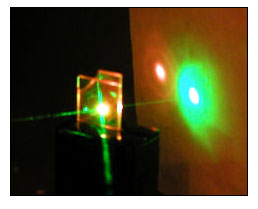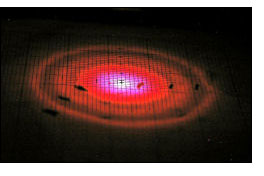CAMBRIDGE, England, Dec. 19 -- The University of Cambridge Engineering Department was awarded 2.4 million pounds (about US$4.21 million) under a publicly sponsored Basic Technology Research Initiative to develop microscopic lasers.

Photograph of a lasing liquid crystal cell (Photo courtesy Department Engineering at the University of Cambridge)
These new lasers, based on liquid crystals and light-emitting polymers, will combine the best features of dye, gas and diode lasers. The project is a multidisciplinary collaborative research project between the university's engineering, physics and chemistry departments. Harry Coles, an engineering professor, is the principal investigator.
Coles said, "Dye lasers can be tuned to emit different wavelengths, but they are large. Gas lasers are powerful and stable, but they cannot be tuned and are also fairly large. Diode lasers such as those used in CD and DVD players are small but can't be tuned. The new lasers will be extremely small -- less than the width of a human hair -- and stable, and will emit very pure light, because they will not hop from one mode of emissions to another. It will be possible to tune them to any wavelength, from ultraviolet to infrared, simply by sending them an electrical signal."

Photograph of the far field diffraction rings of the liquid crystal laser emission (Photo courtesy Department Engineering at the University of Cambridge)
The lasers are also relatively inexpensive to make, and they can be incorporated into fiber optics, with possible applications in dermatology, cancer and diabetes detection, or in "lab-on-a-chip" technology. They will combine spectroscopic measurement and analysis on a single chip, making it possible for medical staff, environmental officals and others to conduct analyses in the field, rather than sending samples to a lab and waiting for the results. Other potential applications are telecommunications devices and the booming display market for TVs, computers, mobile phones, and other consumer devices.
The lasers are small enough to act as individual picture elements of a display, and they can be switched fast enough to provide bright pure light of any color. No filters or backlighting will be required, so the display will be brighter, sharper and consume less power, Coles said.
For more information, visit: www.eng.cam.ac.uk